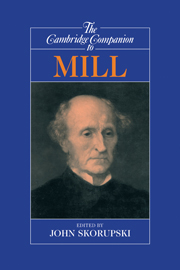Book contents
- Frontmatter
- Introduction
- 1 Mill on language and logic
- 2 Mill, mathematics, and the naturalist tradition
- 3 Mill on induction and scientific method
- 4 Mill, phenomenalism, and the self
- 5 Mill on religion
- 6 Mill on psychology and the moral sciences
- 7 Mill's utilitarianism
- 8 Mill's political economy
- 9 Civilization and culture as moral concepts
- 10 Democracy, socialism, and the working classes
- 11 The subjection of women
- 12 Mill and the Classical world
- 13 The reception and early reputation of Mill's political thought
- 14 Mill in a liberal landscape
- Guide to further reading
- Bibliography
- Index
4 - Mill, phenomenalism, and the self
Published online by Cambridge University Press: 28 May 2006
- Frontmatter
- Introduction
- 1 Mill on language and logic
- 2 Mill, mathematics, and the naturalist tradition
- 3 Mill on induction and scientific method
- 4 Mill, phenomenalism, and the self
- 5 Mill on religion
- 6 Mill on psychology and the moral sciences
- 7 Mill's utilitarianism
- 8 Mill's political economy
- 9 Civilization and culture as moral concepts
- 10 Democracy, socialism, and the working classes
- 11 The subjection of women
- 12 Mill and the Classical world
- 13 The reception and early reputation of Mill's political thought
- 14 Mill in a liberal landscape
- Guide to further reading
- Bibliography
- Index
Summary
THE ORIGINS OF MILL S PHENOMENALISM! BERKELEY, HAMILTON AND THE RELATIVITY OF KNOWLEDGE
“Matter, then, may be defined as the Permanent Possibility of Sensation”. With this famous phrase, Mill put phenomenalism firmly on the philosophical map. The origins of phenomenalism - the standpoint which regards sensations as the basic constituents of reality, and attempts to construct the external world from sensations and the possibilities of sensation - can be traced back to Berkeley. But the analysis of matter as the “permanent possibility of sensation” and the attempted application of that analysis to mind in the best-known chapters of Mill's Examination of Sir William Hamilton's Philosophy constitute the first developed presentation of the doctrine. After Mill, a commitment to phenomenalism became standard among scientific philosophers, until superseded by physicalism in the 1930s. Figures associated with the doctrine included Mach, Russell, Carnap, C. I. Lewis and A. J. Ayer, and with these it took an increasingly “linguistic” or “semantic” form.
- Type
- Chapter
- Information
- The Cambridge Companion to Mill , pp. 139 - 175Publisher: Cambridge University PressPrint publication year: 1998
- 6
- Cited by

